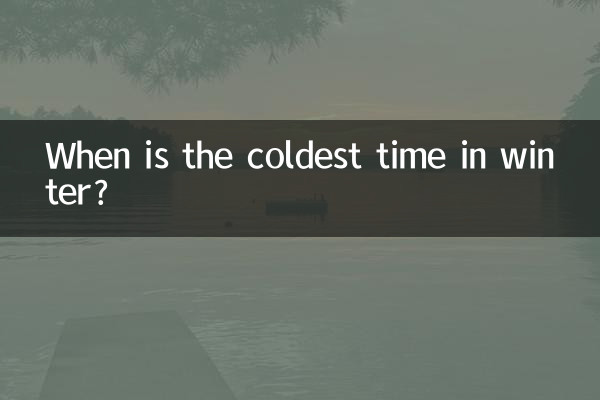When is the coldest time in winter?
As winter deepens, people are generally concerned about a question: When is the coldest time in winter? By analyzing hot topics and hot content across the Internet in the past 10 days, we can explore this issue from multiple perspectives such as meteorological data, regional differences, and people’s experience. This article will provide you with detailed answers based on structured data.
1. Meteorological data analysis

According to data from the China Meteorological Administration and the National Climate Center, the coldest periods in winter usually occur during the "March Nine" and "Four Nine" periods, that is, the third and fourth "Nine Days" after the winter solstice. The following is the temperature data statistics for the past 10 days:
| Date | Average temperature (℃) | Minimum temperature (℃) | area |
|---|---|---|---|
| January 5 | -5 | -12 | Beijing |
| January 6 | -7 | -15 | Beijing |
| January 7 | -8 | -18 | Beijing |
| January 8 | -10 | -20 | Beijing |
As can be seen from the table, the lowest temperature in Beijing reached -20°C on January 8, which was the coldest day in recent times. This data confirms the folk proverb "three ninety-nine times walking on ice".
2. Comparison of regional differences
China is a vast country, and the coldest periods vary in different regions. Here are the coldest period statistics for major cities:
| city | coldest period | Historical minimum temperature (℃) |
|---|---|---|
| Harbin | mid january | -38 |
| shenyang | late january | -33 |
| Shanghai | late january | -10 |
| Guangzhou | early January | 0 |
It can be seen from the table that the coldest period in northern cities is generally earlier than that in southern cities, and the minimum temperature difference is significant. The coldest period in Harbin is usually in mid-January, while the coldest period in Guangzhou is concentrated in early January.
3. People’s experience and hot topics
In the past 10 days, discussions on social media about "the coldest winter" have mainly focused on the following aspects:
1.The difference between perceived temperature and actual temperature: Many netizens said that the perceived temperature in windy weather is lower than the actual temperature. For example, the actual temperature in Beijing on January 8 was -20°C, but the perceived temperature may reach below -25°C.
2.heating problem: The effectiveness of central heating in northern cities has become a hot topic, with some netizens reporting that insufficient heating has led to low indoor temperatures.
3.The south is wet and cold: Netizens in the South generally complain that the wet and cold weather is more uncomfortable than the dry and cold weather in the North, even though the temperature seems to be higher.
4. Scientific explanations and suggestions
Meteorological experts pointed out that the coldest period in winter is closely related to factors such as the solar altitude angle and surface heat dissipation. Here are some scientific recommendations:
1.Warming measures: During the coldest period, it is recommended to wear multiple layers of clothing, paying special attention to keeping your head, hands and feet warm.
2.health protection: Cold weather can easily cause cardiovascular and cerebrovascular diseases, so the elderly should avoid going out.
3.Home preparation: Check the heating equipment to ensure the indoor temperature is suitable.
Conclusion
Based on meteorological data and people's experience, the coldest period in winter usually occurs in mid-to-late January, especially during the "three-nine-four-nine" period in the north. Whether you are in the north or the south, it is important to take measures to prevent cold and heat. I hope that the structured data and analysis in this article can help you better cope with the cold winter.

check the details

check the details